Analysis of Transfer Pricing Approaches for Raven Industries
VerifiedAdded on 2022/11/26
|14
|3695
|443
Report
AI Summary
This report provides a comprehensive analysis of transfer pricing methods within the context of Raven Industries, a company with three divisions. The report begins by assessing the validity of a statement made by Cleveland regarding the profitability of the cushion division and the impact of transfer pricing. It then explores various transfer pricing approaches, including negotiated pricing and dual pricing, comparing their advantages and disadvantages. The report emphasizes the importance of aligning divisional goals with overall corporate objectives and the role of performance measurement in enhancing productivity. A revised profit statement based on the contribution margin approach is presented to evaluate divisional performance. Finally, the report concludes by recommending the best transfer pricing approach for the company. The analysis includes financial statements and calculations to support the recommendations.

Management Accounting
Paraphrase This Document
Need a fresh take? Get an instant paraphrase of this document with our AI Paraphraser
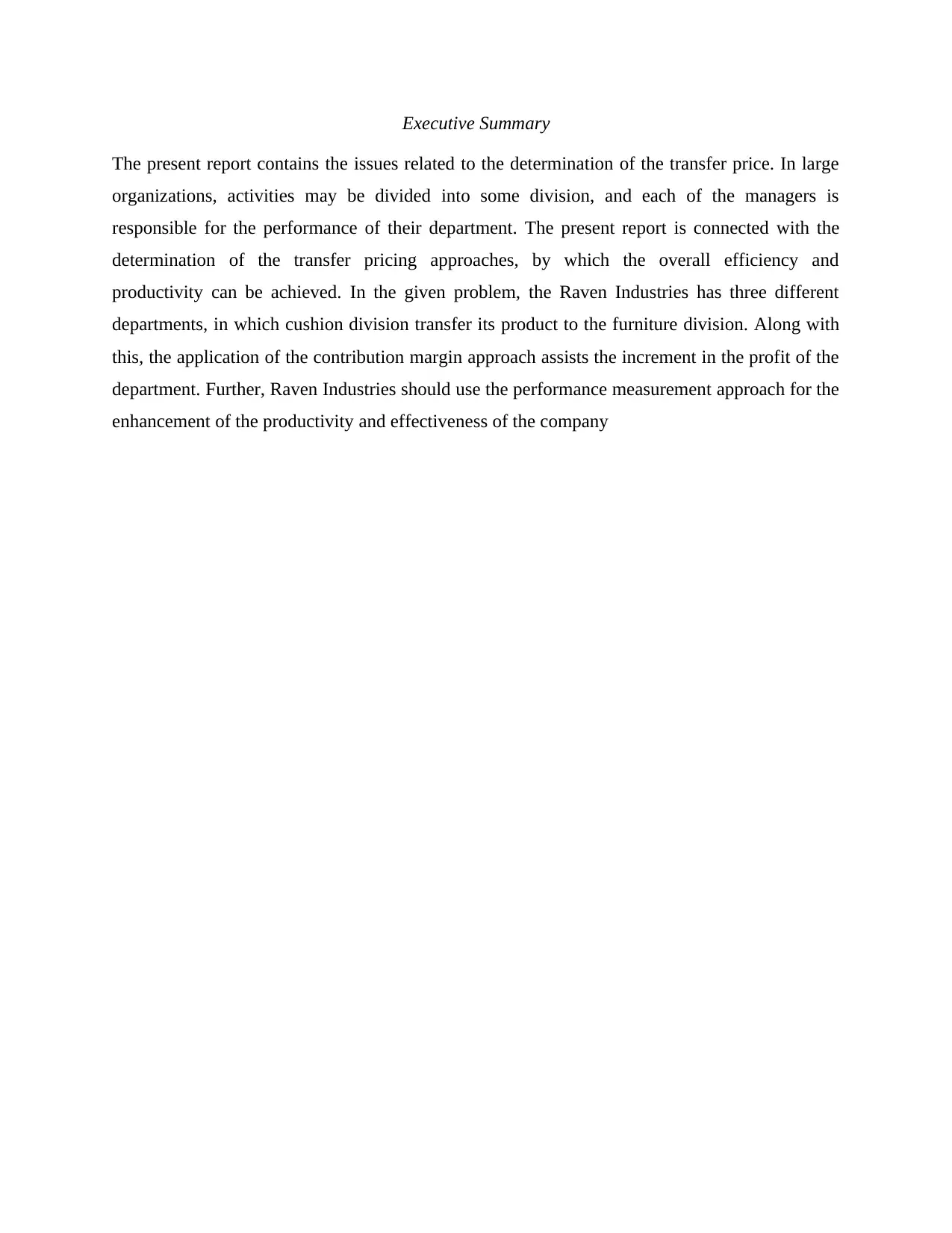
Executive Summary
The present report contains the issues related to the determination of the transfer price. In large
organizations, activities may be divided into some division, and each of the managers is
responsible for the performance of their department. The present report is connected with the
determination of the transfer pricing approaches, by which the overall efficiency and
productivity can be achieved. In the given problem, the Raven Industries has three different
departments, in which cushion division transfer its product to the furniture division. Along with
this, the application of the contribution margin approach assists the increment in the profit of the
department. Further, Raven Industries should use the performance measurement approach for the
enhancement of the productivity and effectiveness of the company
The present report contains the issues related to the determination of the transfer price. In large
organizations, activities may be divided into some division, and each of the managers is
responsible for the performance of their department. The present report is connected with the
determination of the transfer pricing approaches, by which the overall efficiency and
productivity can be achieved. In the given problem, the Raven Industries has three different
departments, in which cushion division transfer its product to the furniture division. Along with
this, the application of the contribution margin approach assists the increment in the profit of the
department. Further, Raven Industries should use the performance measurement approach for the
enhancement of the productivity and effectiveness of the company
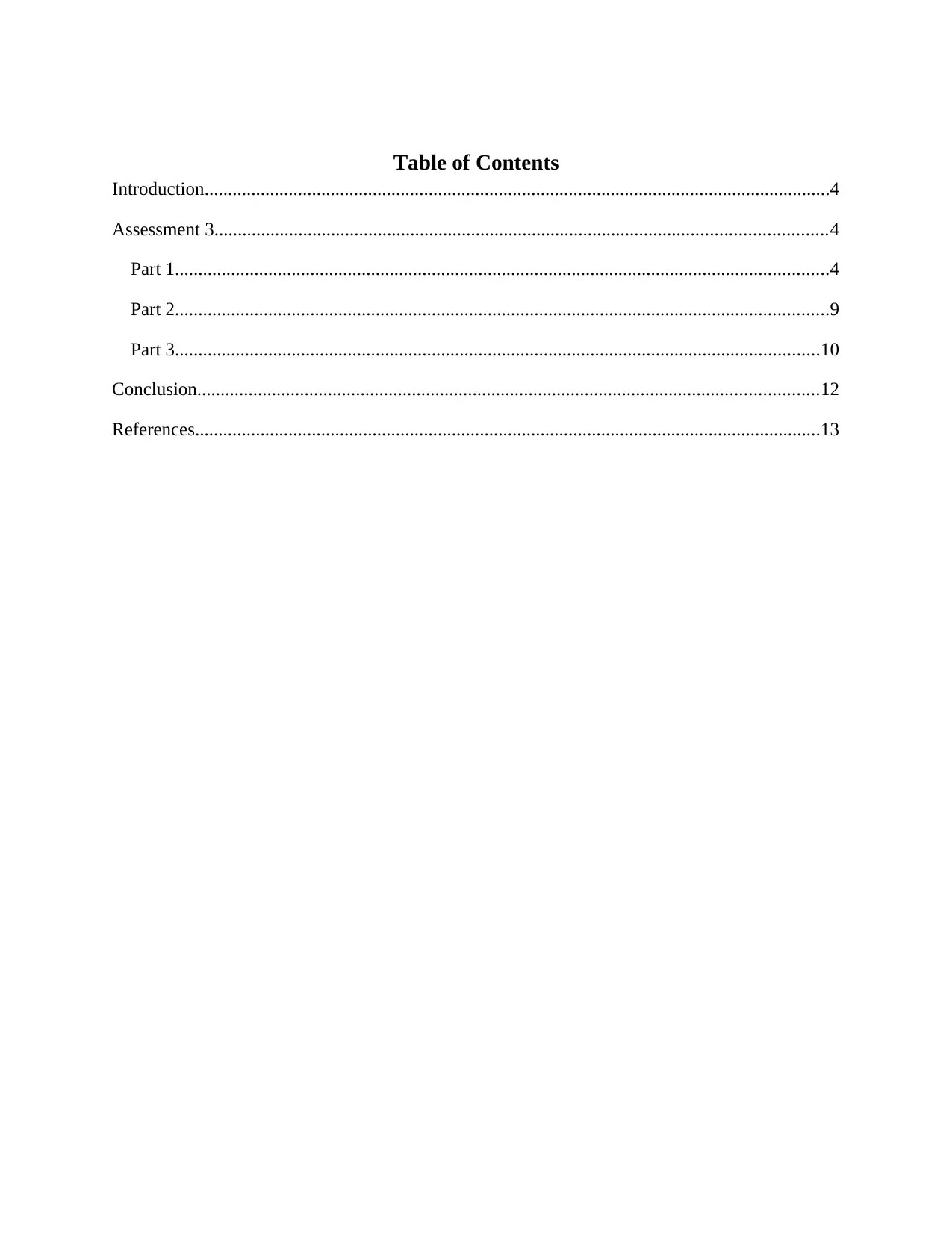
Table of Contents
Introduction......................................................................................................................................4
Assessment 3...................................................................................................................................4
Part 1............................................................................................................................................4
Part 2............................................................................................................................................9
Part 3..........................................................................................................................................10
Conclusion.....................................................................................................................................12
References......................................................................................................................................13
Introduction......................................................................................................................................4
Assessment 3...................................................................................................................................4
Part 1............................................................................................................................................4
Part 2............................................................................................................................................9
Part 3..........................................................................................................................................10
Conclusion.....................................................................................................................................12
References......................................................................................................................................13
⊘ This is a preview!⊘
Do you want full access?
Subscribe today to unlock all pages.

Trusted by 1+ million students worldwide
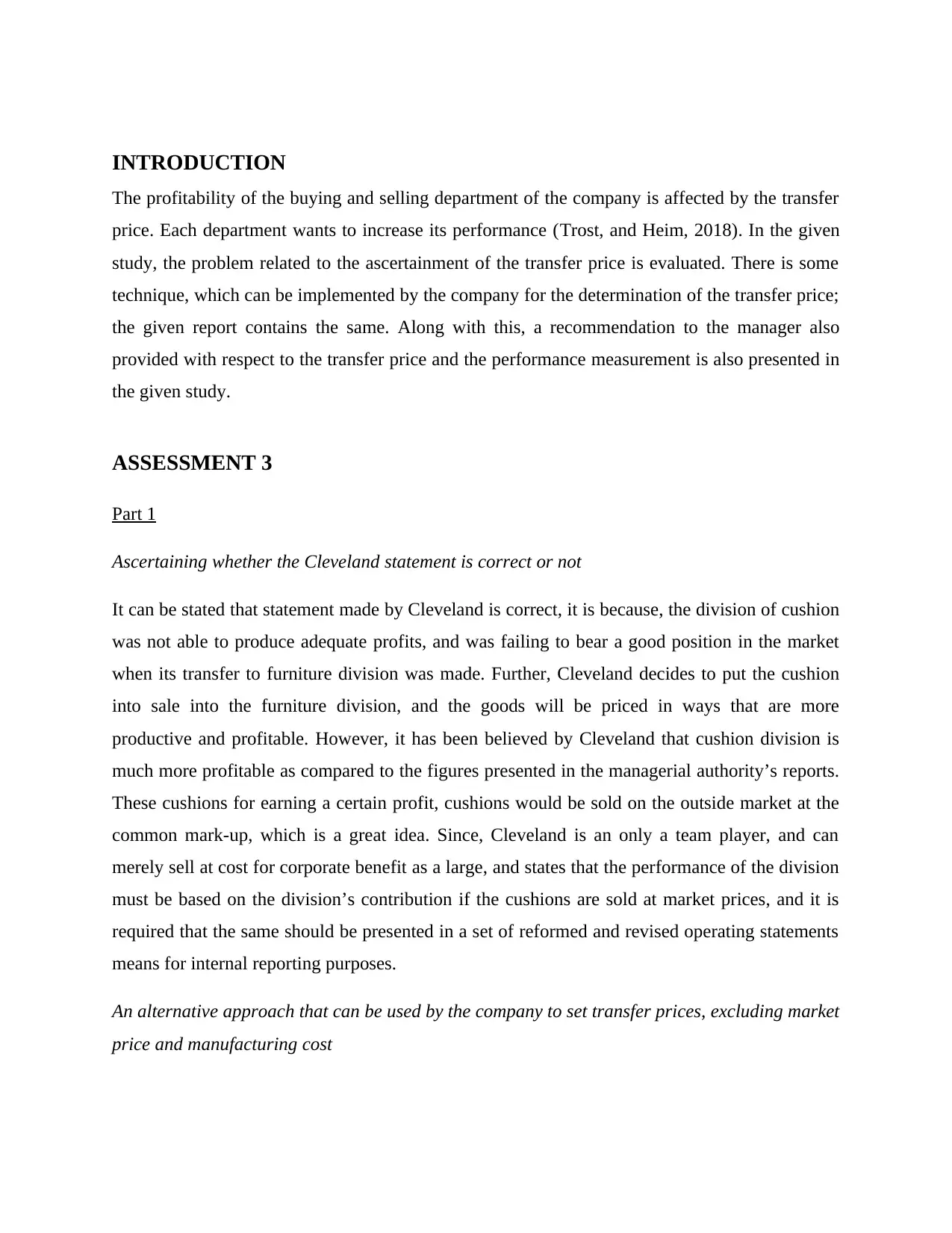
INTRODUCTION
The profitability of the buying and selling department of the company is affected by the transfer
price. Each department wants to increase its performance (Trost, and Heim, 2018). In the given
study, the problem related to the ascertainment of the transfer price is evaluated. There is some
technique, which can be implemented by the company for the determination of the transfer price;
the given report contains the same. Along with this, a recommendation to the manager also
provided with respect to the transfer price and the performance measurement is also presented in
the given study.
ASSESSMENT 3
Part 1
Ascertaining whether the Cleveland statement is correct or not
It can be stated that statement made by Cleveland is correct, it is because, the division of cushion
was not able to produce adequate profits, and was failing to bear a good position in the market
when its transfer to furniture division was made. Further, Cleveland decides to put the cushion
into sale into the furniture division, and the goods will be priced in ways that are more
productive and profitable. However, it has been believed by Cleveland that cushion division is
much more profitable as compared to the figures presented in the managerial authority’s reports.
These cushions for earning a certain profit, cushions would be sold on the outside market at the
common mark-up, which is a great idea. Since, Cleveland is an only a team player, and can
merely sell at cost for corporate benefit as a large, and states that the performance of the division
must be based on the division’s contribution if the cushions are sold at market prices, and it is
required that the same should be presented in a set of reformed and revised operating statements
means for internal reporting purposes.
An alternative approach that can be used by the company to set transfer prices, excluding market
price and manufacturing cost
The profitability of the buying and selling department of the company is affected by the transfer
price. Each department wants to increase its performance (Trost, and Heim, 2018). In the given
study, the problem related to the ascertainment of the transfer price is evaluated. There is some
technique, which can be implemented by the company for the determination of the transfer price;
the given report contains the same. Along with this, a recommendation to the manager also
provided with respect to the transfer price and the performance measurement is also presented in
the given study.
ASSESSMENT 3
Part 1
Ascertaining whether the Cleveland statement is correct or not
It can be stated that statement made by Cleveland is correct, it is because, the division of cushion
was not able to produce adequate profits, and was failing to bear a good position in the market
when its transfer to furniture division was made. Further, Cleveland decides to put the cushion
into sale into the furniture division, and the goods will be priced in ways that are more
productive and profitable. However, it has been believed by Cleveland that cushion division is
much more profitable as compared to the figures presented in the managerial authority’s reports.
These cushions for earning a certain profit, cushions would be sold on the outside market at the
common mark-up, which is a great idea. Since, Cleveland is an only a team player, and can
merely sell at cost for corporate benefit as a large, and states that the performance of the division
must be based on the division’s contribution if the cushions are sold at market prices, and it is
required that the same should be presented in a set of reformed and revised operating statements
means for internal reporting purposes.
An alternative approach that can be used by the company to set transfer prices, excluding market
price and manufacturing cost
Paraphrase This Document
Need a fresh take? Get an instant paraphrase of this document with our AI Paraphraser
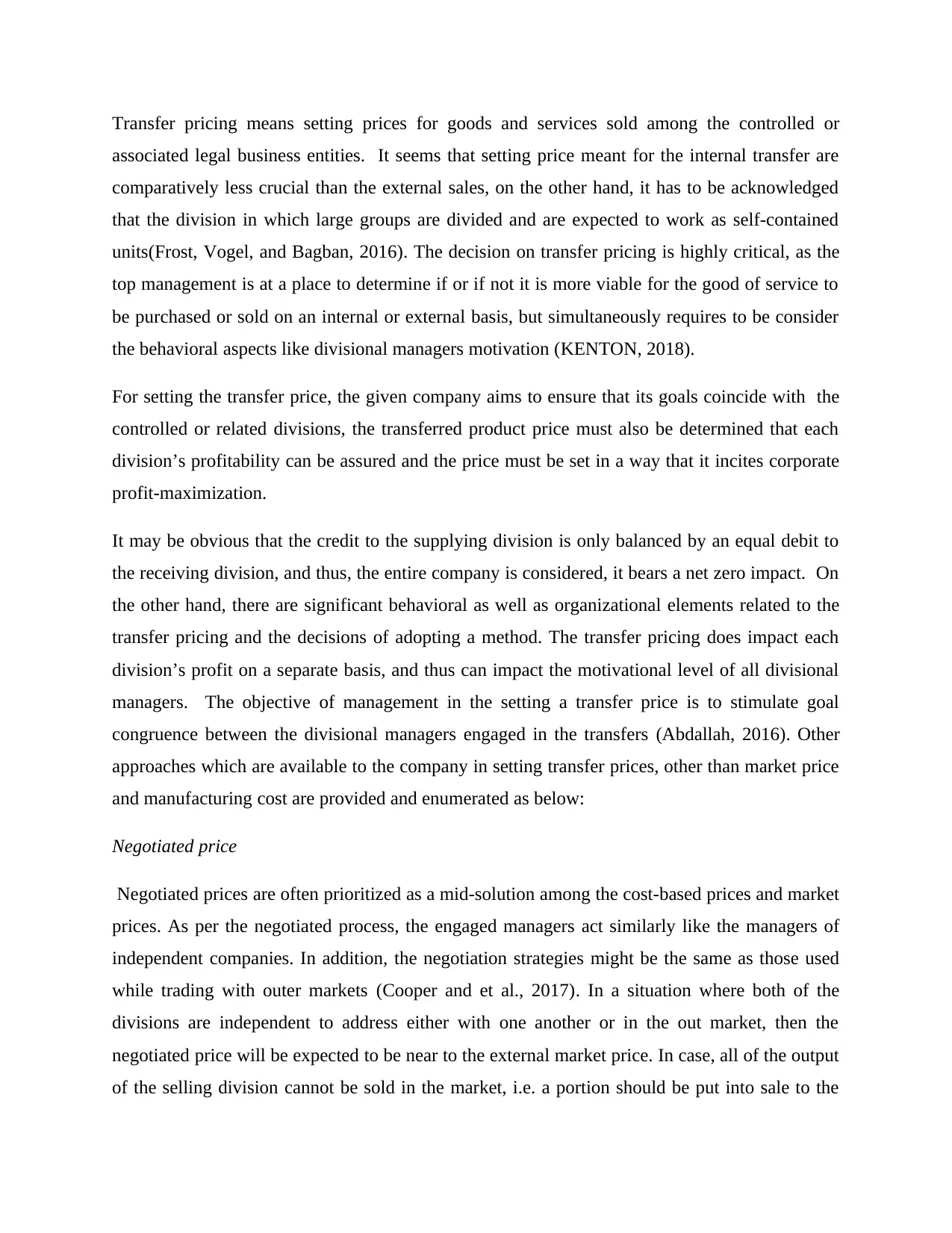
Transfer pricing means setting prices for goods and services sold among the controlled or
associated legal business entities. It seems that setting price meant for the internal transfer are
comparatively less crucial than the external sales, on the other hand, it has to be acknowledged
that the division in which large groups are divided and are expected to work as self-contained
units(Frost, Vogel, and Bagban, 2016). The decision on transfer pricing is highly critical, as the
top management is at a place to determine if or if not it is more viable for the good of service to
be purchased or sold on an internal or external basis, but simultaneously requires to be consider
the behavioral aspects like divisional managers motivation (KENTON, 2018).
For setting the transfer price, the given company aims to ensure that its goals coincide with the
controlled or related divisions, the transferred product price must also be determined that each
division’s profitability can be assured and the price must be set in a way that it incites corporate
profit-maximization.
It may be obvious that the credit to the supplying division is only balanced by an equal debit to
the receiving division, and thus, the entire company is considered, it bears a net zero impact. On
the other hand, there are significant behavioral as well as organizational elements related to the
transfer pricing and the decisions of adopting a method. The transfer pricing does impact each
division’s profit on a separate basis, and thus can impact the motivational level of all divisional
managers. The objective of management in the setting a transfer price is to stimulate goal
congruence between the divisional managers engaged in the transfers (Abdallah, 2016). Other
approaches which are available to the company in setting transfer prices, other than market price
and manufacturing cost are provided and enumerated as below:
Negotiated price
Negotiated prices are often prioritized as a mid-solution among the cost-based prices and market
prices. As per the negotiated process, the engaged managers act similarly like the managers of
independent companies. In addition, the negotiation strategies might be the same as those used
while trading with outer markets (Cooper and et al., 2017). In a situation where both of the
divisions are independent to address either with one another or in the out market, then the
negotiated price will be expected to be near to the external market price. In case, all of the output
of the selling division cannot be sold in the market, i.e. a portion should be put into sale to the
associated legal business entities. It seems that setting price meant for the internal transfer are
comparatively less crucial than the external sales, on the other hand, it has to be acknowledged
that the division in which large groups are divided and are expected to work as self-contained
units(Frost, Vogel, and Bagban, 2016). The decision on transfer pricing is highly critical, as the
top management is at a place to determine if or if not it is more viable for the good of service to
be purchased or sold on an internal or external basis, but simultaneously requires to be consider
the behavioral aspects like divisional managers motivation (KENTON, 2018).
For setting the transfer price, the given company aims to ensure that its goals coincide with the
controlled or related divisions, the transferred product price must also be determined that each
division’s profitability can be assured and the price must be set in a way that it incites corporate
profit-maximization.
It may be obvious that the credit to the supplying division is only balanced by an equal debit to
the receiving division, and thus, the entire company is considered, it bears a net zero impact. On
the other hand, there are significant behavioral as well as organizational elements related to the
transfer pricing and the decisions of adopting a method. The transfer pricing does impact each
division’s profit on a separate basis, and thus can impact the motivational level of all divisional
managers. The objective of management in the setting a transfer price is to stimulate goal
congruence between the divisional managers engaged in the transfers (Abdallah, 2016). Other
approaches which are available to the company in setting transfer prices, other than market price
and manufacturing cost are provided and enumerated as below:
Negotiated price
Negotiated prices are often prioritized as a mid-solution among the cost-based prices and market
prices. As per the negotiated process, the engaged managers act similarly like the managers of
independent companies. In addition, the negotiation strategies might be the same as those used
while trading with outer markets (Cooper and et al., 2017). In a situation where both of the
divisions are independent to address either with one another or in the out market, then the
negotiated price will be expected to be near to the external market price. In case, all of the output
of the selling division cannot be sold in the market, i.e. a portion should be put into sale to the
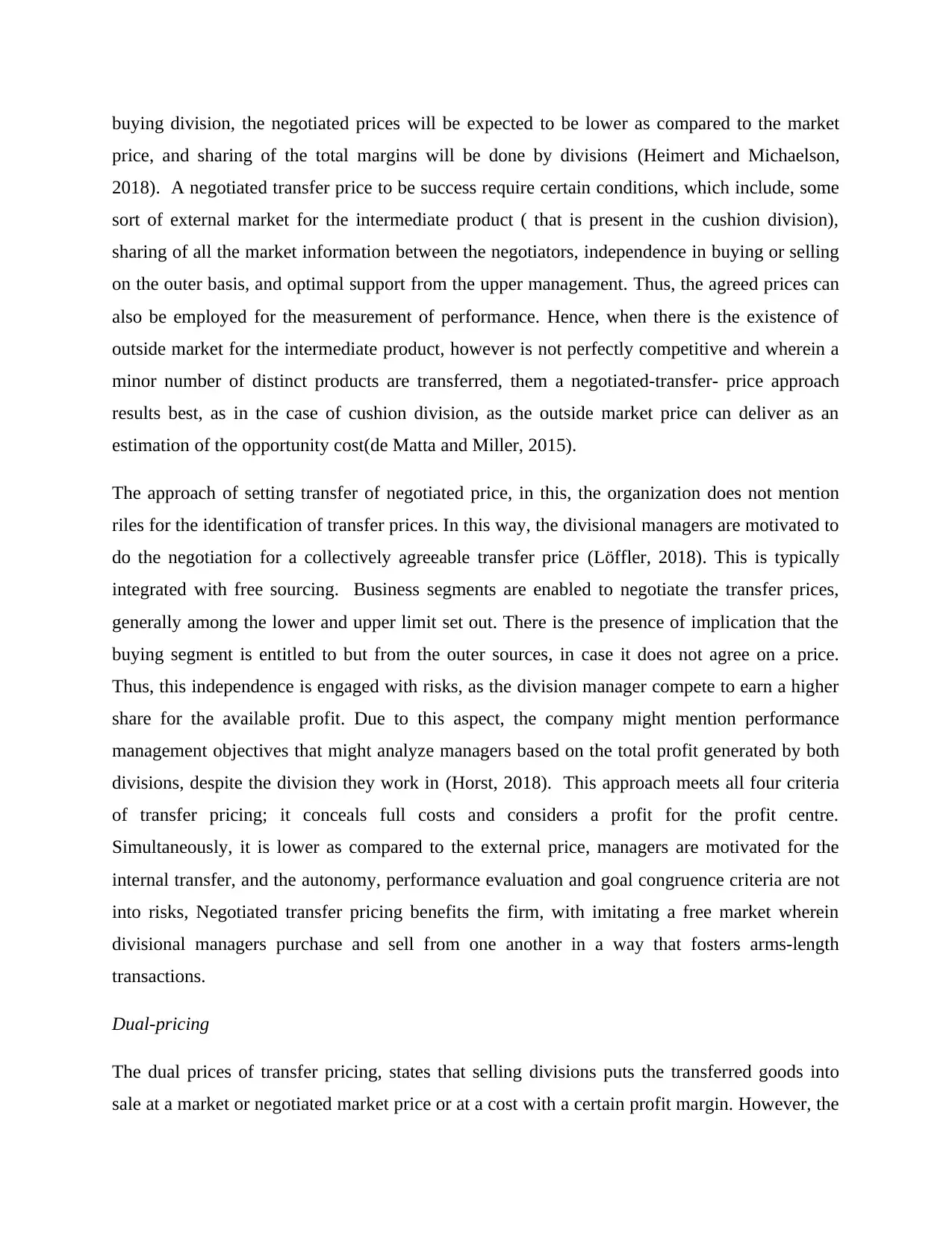
buying division, the negotiated prices will be expected to be lower as compared to the market
price, and sharing of the total margins will be done by divisions (Heimert and Michaelson,
2018). A negotiated transfer price to be success require certain conditions, which include, some
sort of external market for the intermediate product ( that is present in the cushion division),
sharing of all the market information between the negotiators, independence in buying or selling
on the outer basis, and optimal support from the upper management. Thus, the agreed prices can
also be employed for the measurement of performance. Hence, when there is the existence of
outside market for the intermediate product, however is not perfectly competitive and wherein a
minor number of distinct products are transferred, them a negotiated-transfer- price approach
results best, as in the case of cushion division, as the outside market price can deliver as an
estimation of the opportunity cost(de Matta and Miller, 2015).
The approach of setting transfer of negotiated price, in this, the organization does not mention
riles for the identification of transfer prices. In this way, the divisional managers are motivated to
do the negotiation for a collectively agreeable transfer price (Löffler, 2018). This is typically
integrated with free sourcing. Business segments are enabled to negotiate the transfer prices,
generally among the lower and upper limit set out. There is the presence of implication that the
buying segment is entitled to but from the outer sources, in case it does not agree on a price.
Thus, this independence is engaged with risks, as the division manager compete to earn a higher
share for the available profit. Due to this aspect, the company might mention performance
management objectives that might analyze managers based on the total profit generated by both
divisions, despite the division they work in (Horst, 2018). This approach meets all four criteria
of transfer pricing; it conceals full costs and considers a profit for the profit centre.
Simultaneously, it is lower as compared to the external price, managers are motivated for the
internal transfer, and the autonomy, performance evaluation and goal congruence criteria are not
into risks, Negotiated transfer pricing benefits the firm, with imitating a free market wherein
divisional managers purchase and sell from one another in a way that fosters arms-length
transactions.
Dual-pricing
The dual prices of transfer pricing, states that selling divisions puts the transferred goods into
sale at a market or negotiated market price or at a cost with a certain profit margin. However, the
price, and sharing of the total margins will be done by divisions (Heimert and Michaelson,
2018). A negotiated transfer price to be success require certain conditions, which include, some
sort of external market for the intermediate product ( that is present in the cushion division),
sharing of all the market information between the negotiators, independence in buying or selling
on the outer basis, and optimal support from the upper management. Thus, the agreed prices can
also be employed for the measurement of performance. Hence, when there is the existence of
outside market for the intermediate product, however is not perfectly competitive and wherein a
minor number of distinct products are transferred, them a negotiated-transfer- price approach
results best, as in the case of cushion division, as the outside market price can deliver as an
estimation of the opportunity cost(de Matta and Miller, 2015).
The approach of setting transfer of negotiated price, in this, the organization does not mention
riles for the identification of transfer prices. In this way, the divisional managers are motivated to
do the negotiation for a collectively agreeable transfer price (Löffler, 2018). This is typically
integrated with free sourcing. Business segments are enabled to negotiate the transfer prices,
generally among the lower and upper limit set out. There is the presence of implication that the
buying segment is entitled to but from the outer sources, in case it does not agree on a price.
Thus, this independence is engaged with risks, as the division manager compete to earn a higher
share for the available profit. Due to this aspect, the company might mention performance
management objectives that might analyze managers based on the total profit generated by both
divisions, despite the division they work in (Horst, 2018). This approach meets all four criteria
of transfer pricing; it conceals full costs and considers a profit for the profit centre.
Simultaneously, it is lower as compared to the external price, managers are motivated for the
internal transfer, and the autonomy, performance evaluation and goal congruence criteria are not
into risks, Negotiated transfer pricing benefits the firm, with imitating a free market wherein
divisional managers purchase and sell from one another in a way that fosters arms-length
transactions.
Dual-pricing
The dual prices of transfer pricing, states that selling divisions puts the transferred goods into
sale at a market or negotiated market price or at a cost with a certain profit margin. However, the
⊘ This is a preview!⊘
Do you want full access?
Subscribe today to unlock all pages.

Trusted by 1+ million students worldwide
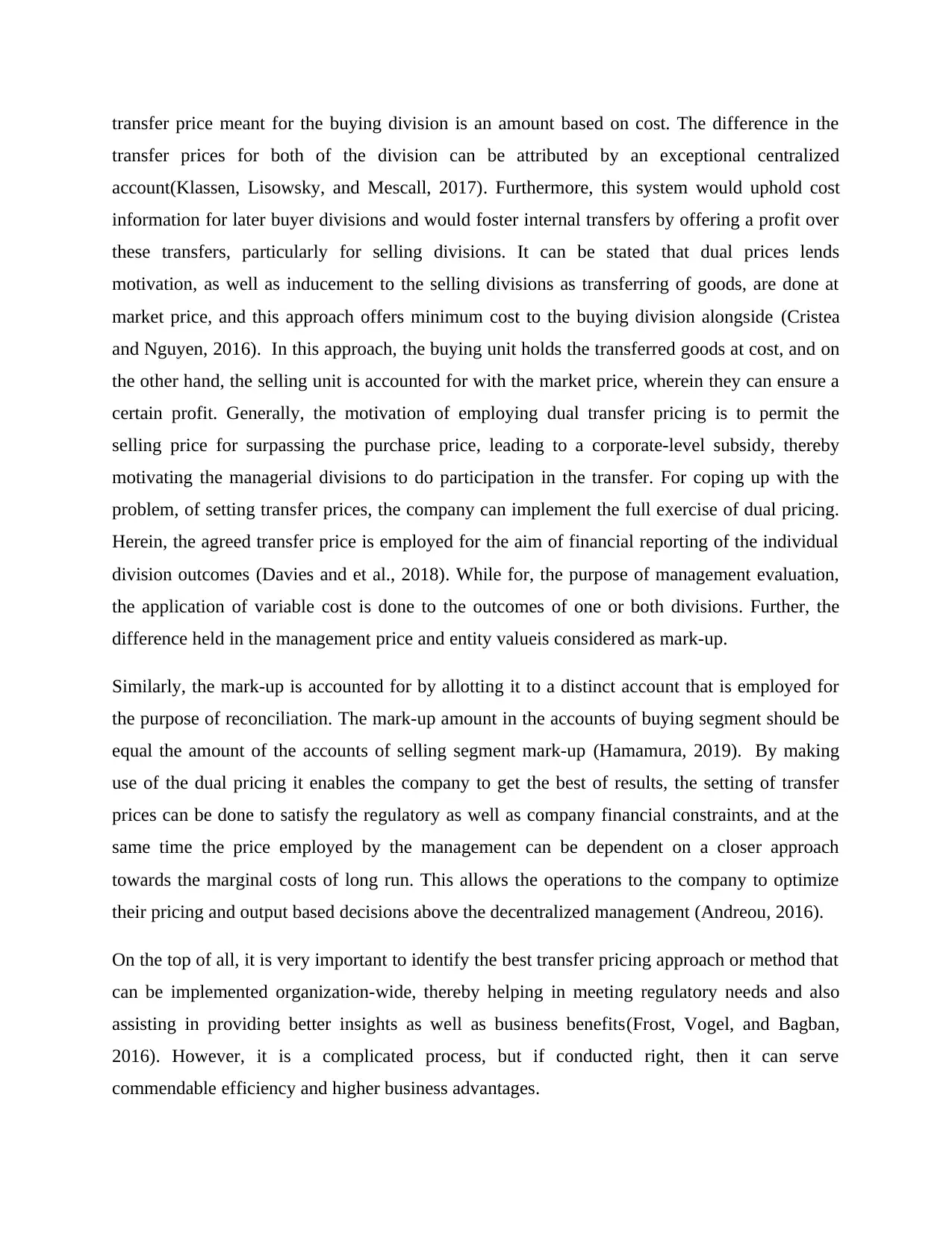
transfer price meant for the buying division is an amount based on cost. The difference in the
transfer prices for both of the division can be attributed by an exceptional centralized
account(Klassen, Lisowsky, and Mescall, 2017). Furthermore, this system would uphold cost
information for later buyer divisions and would foster internal transfers by offering a profit over
these transfers, particularly for selling divisions. It can be stated that dual prices lends
motivation, as well as inducement to the selling divisions as transferring of goods, are done at
market price, and this approach offers minimum cost to the buying division alongside (Cristea
and Nguyen, 2016). In this approach, the buying unit holds the transferred goods at cost, and on
the other hand, the selling unit is accounted for with the market price, wherein they can ensure a
certain profit. Generally, the motivation of employing dual transfer pricing is to permit the
selling price for surpassing the purchase price, leading to a corporate-level subsidy, thereby
motivating the managerial divisions to do participation in the transfer. For coping up with the
problem, of setting transfer prices, the company can implement the full exercise of dual pricing.
Herein, the agreed transfer price is employed for the aim of financial reporting of the individual
division outcomes (Davies and et al., 2018). While for, the purpose of management evaluation,
the application of variable cost is done to the outcomes of one or both divisions. Further, the
difference held in the management price and entity valueis considered as mark-up.
Similarly, the mark-up is accounted for by allotting it to a distinct account that is employed for
the purpose of reconciliation. The mark-up amount in the accounts of buying segment should be
equal the amount of the accounts of selling segment mark-up (Hamamura, 2019). By making
use of the dual pricing it enables the company to get the best of results, the setting of transfer
prices can be done to satisfy the regulatory as well as company financial constraints, and at the
same time the price employed by the management can be dependent on a closer approach
towards the marginal costs of long run. This allows the operations to the company to optimize
their pricing and output based decisions above the decentralized management (Andreou, 2016).
On the top of all, it is very important to identify the best transfer pricing approach or method that
can be implemented organization-wide, thereby helping in meeting regulatory needs and also
assisting in providing better insights as well as business benefits(Frost, Vogel, and Bagban,
2016). However, it is a complicated process, but if conducted right, then it can serve
commendable efficiency and higher business advantages.
transfer prices for both of the division can be attributed by an exceptional centralized
account(Klassen, Lisowsky, and Mescall, 2017). Furthermore, this system would uphold cost
information for later buyer divisions and would foster internal transfers by offering a profit over
these transfers, particularly for selling divisions. It can be stated that dual prices lends
motivation, as well as inducement to the selling divisions as transferring of goods, are done at
market price, and this approach offers minimum cost to the buying division alongside (Cristea
and Nguyen, 2016). In this approach, the buying unit holds the transferred goods at cost, and on
the other hand, the selling unit is accounted for with the market price, wherein they can ensure a
certain profit. Generally, the motivation of employing dual transfer pricing is to permit the
selling price for surpassing the purchase price, leading to a corporate-level subsidy, thereby
motivating the managerial divisions to do participation in the transfer. For coping up with the
problem, of setting transfer prices, the company can implement the full exercise of dual pricing.
Herein, the agreed transfer price is employed for the aim of financial reporting of the individual
division outcomes (Davies and et al., 2018). While for, the purpose of management evaluation,
the application of variable cost is done to the outcomes of one or both divisions. Further, the
difference held in the management price and entity valueis considered as mark-up.
Similarly, the mark-up is accounted for by allotting it to a distinct account that is employed for
the purpose of reconciliation. The mark-up amount in the accounts of buying segment should be
equal the amount of the accounts of selling segment mark-up (Hamamura, 2019). By making
use of the dual pricing it enables the company to get the best of results, the setting of transfer
prices can be done to satisfy the regulatory as well as company financial constraints, and at the
same time the price employed by the management can be dependent on a closer approach
towards the marginal costs of long run. This allows the operations to the company to optimize
their pricing and output based decisions above the decentralized management (Andreou, 2016).
On the top of all, it is very important to identify the best transfer pricing approach or method that
can be implemented organization-wide, thereby helping in meeting regulatory needs and also
assisting in providing better insights as well as business benefits(Frost, Vogel, and Bagban,
2016). However, it is a complicated process, but if conducted right, then it can serve
commendable efficiency and higher business advantages.
Paraphrase This Document
Need a fresh take? Get an instant paraphrase of this document with our AI Paraphraser
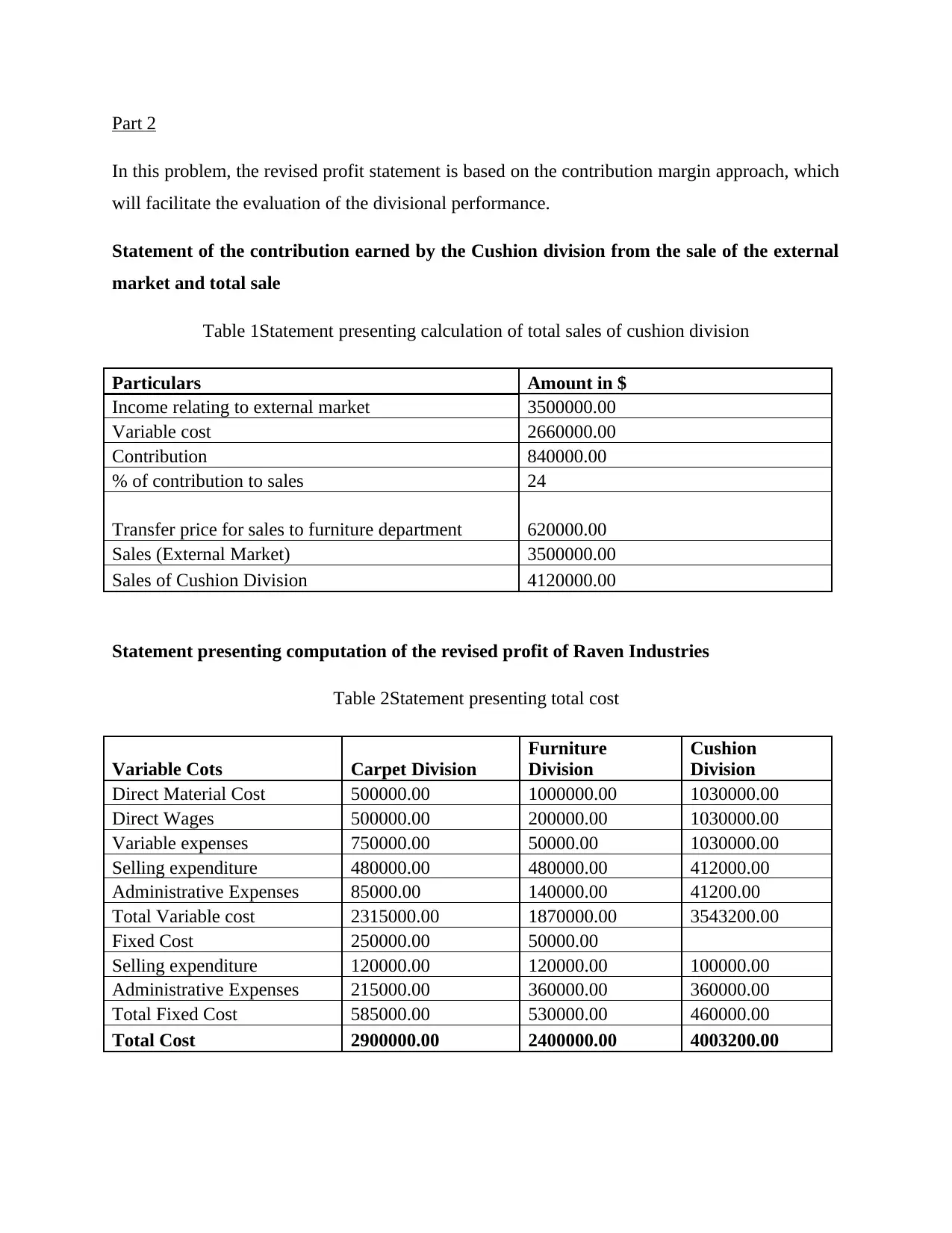
Part 2
In this problem, the revised profit statement is based on the contribution margin approach, which
will facilitate the evaluation of the divisional performance.
Statement of the contribution earned by the Cushion division from the sale of the external
market and total sale
Table 1Statement presenting calculation of total sales of cushion division
Particulars Amount in $
Income relating to external market 3500000.00
Variable cost 2660000.00
Contribution 840000.00
% of contribution to sales 24
Transfer price for sales to furniture department 620000.00
Sales (External Market) 3500000.00
Sales of Cushion Division 4120000.00
Statement presenting computation of the revised profit of Raven Industries
Table 2Statement presenting total cost
Variable Cots Carpet Division
Furniture
Division
Cushion
Division
Direct Material Cost 500000.00 1000000.00 1030000.00
Direct Wages 500000.00 200000.00 1030000.00
Variable expenses 750000.00 50000.00 1030000.00
Selling expenditure 480000.00 480000.00 412000.00
Administrative Expenses 85000.00 140000.00 41200.00
Total Variable cost 2315000.00 1870000.00 3543200.00
Fixed Cost 250000.00 50000.00
Selling expenditure 120000.00 120000.00 100000.00
Administrative Expenses 215000.00 360000.00 360000.00
Total Fixed Cost 585000.00 530000.00 460000.00
Total Cost 2900000.00 2400000.00 4003200.00
In this problem, the revised profit statement is based on the contribution margin approach, which
will facilitate the evaluation of the divisional performance.
Statement of the contribution earned by the Cushion division from the sale of the external
market and total sale
Table 1Statement presenting calculation of total sales of cushion division
Particulars Amount in $
Income relating to external market 3500000.00
Variable cost 2660000.00
Contribution 840000.00
% of contribution to sales 24
Transfer price for sales to furniture department 620000.00
Sales (External Market) 3500000.00
Sales of Cushion Division 4120000.00
Statement presenting computation of the revised profit of Raven Industries
Table 2Statement presenting total cost
Variable Cots Carpet Division
Furniture
Division
Cushion
Division
Direct Material Cost 500000.00 1000000.00 1030000.00
Direct Wages 500000.00 200000.00 1030000.00
Variable expenses 750000.00 50000.00 1030000.00
Selling expenditure 480000.00 480000.00 412000.00
Administrative Expenses 85000.00 140000.00 41200.00
Total Variable cost 2315000.00 1870000.00 3543200.00
Fixed Cost 250000.00 50000.00
Selling expenditure 120000.00 120000.00 100000.00
Administrative Expenses 215000.00 360000.00 360000.00
Total Fixed Cost 585000.00 530000.00 460000.00
Total Cost 2900000.00 2400000.00 4003200.00
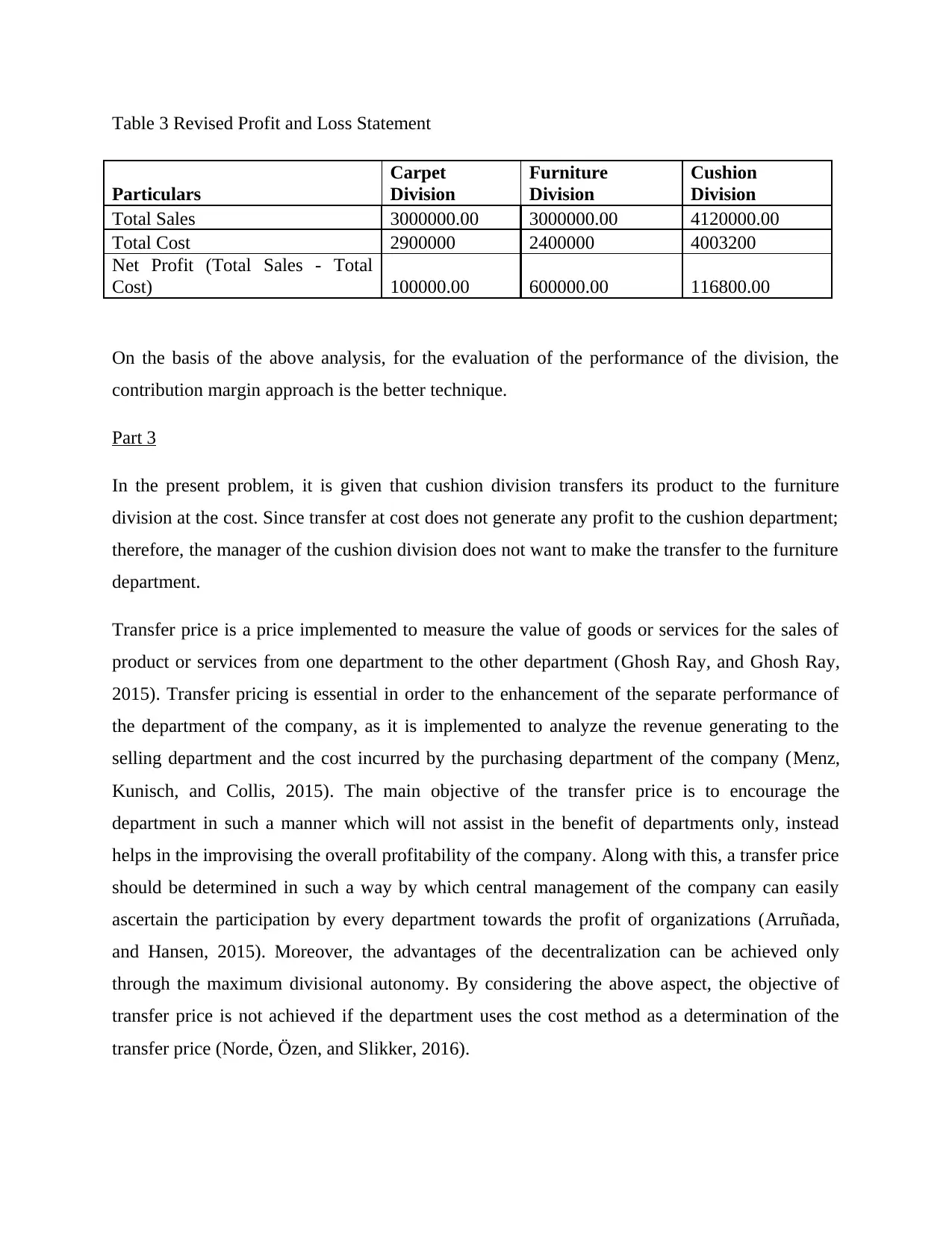
Table 3 Revised Profit and Loss Statement
Particulars
Carpet
Division
Furniture
Division
Cushion
Division
Total Sales 3000000.00 3000000.00 4120000.00
Total Cost 2900000 2400000 4003200
Net Profit (Total Sales - Total
Cost) 100000.00 600000.00 116800.00
On the basis of the above analysis, for the evaluation of the performance of the division, the
contribution margin approach is the better technique.
Part 3
In the present problem, it is given that cushion division transfers its product to the furniture
division at the cost. Since transfer at cost does not generate any profit to the cushion department;
therefore, the manager of the cushion division does not want to make the transfer to the furniture
department.
Transfer price is a price implemented to measure the value of goods or services for the sales of
product or services from one department to the other department (Ghosh Ray, and Ghosh Ray,
2015). Transfer pricing is essential in order to the enhancement of the separate performance of
the department of the company, as it is implemented to analyze the revenue generating to the
selling department and the cost incurred by the purchasing department of the company (Menz,
Kunisch, and Collis, 2015). The main objective of the transfer price is to encourage the
department in such a manner which will not assist in the benefit of departments only, instead
helps in the improvising the overall profitability of the company. Along with this, a transfer price
should be determined in such a way by which central management of the company can easily
ascertain the participation by every department towards the profit of organizations (Arruñada,
and Hansen, 2015). Moreover, the advantages of the decentralization can be achieved only
through the maximum divisional autonomy. By considering the above aspect, the objective of
transfer price is not achieved if the department uses the cost method as a determination of the
transfer price (Norde, Özen, and Slikker, 2016).
Particulars
Carpet
Division
Furniture
Division
Cushion
Division
Total Sales 3000000.00 3000000.00 4120000.00
Total Cost 2900000 2400000 4003200
Net Profit (Total Sales - Total
Cost) 100000.00 600000.00 116800.00
On the basis of the above analysis, for the evaluation of the performance of the division, the
contribution margin approach is the better technique.
Part 3
In the present problem, it is given that cushion division transfers its product to the furniture
division at the cost. Since transfer at cost does not generate any profit to the cushion department;
therefore, the manager of the cushion division does not want to make the transfer to the furniture
department.
Transfer price is a price implemented to measure the value of goods or services for the sales of
product or services from one department to the other department (Ghosh Ray, and Ghosh Ray,
2015). Transfer pricing is essential in order to the enhancement of the separate performance of
the department of the company, as it is implemented to analyze the revenue generating to the
selling department and the cost incurred by the purchasing department of the company (Menz,
Kunisch, and Collis, 2015). The main objective of the transfer price is to encourage the
department in such a manner which will not assist in the benefit of departments only, instead
helps in the improvising the overall profitability of the company. Along with this, a transfer price
should be determined in such a way by which central management of the company can easily
ascertain the participation by every department towards the profit of organizations (Arruñada,
and Hansen, 2015). Moreover, the advantages of the decentralization can be achieved only
through the maximum divisional autonomy. By considering the above aspect, the objective of
transfer price is not achieved if the department uses the cost method as a determination of the
transfer price (Norde, Özen, and Slikker, 2016).
⊘ This is a preview!⊘
Do you want full access?
Subscribe today to unlock all pages.

Trusted by 1+ million students worldwide
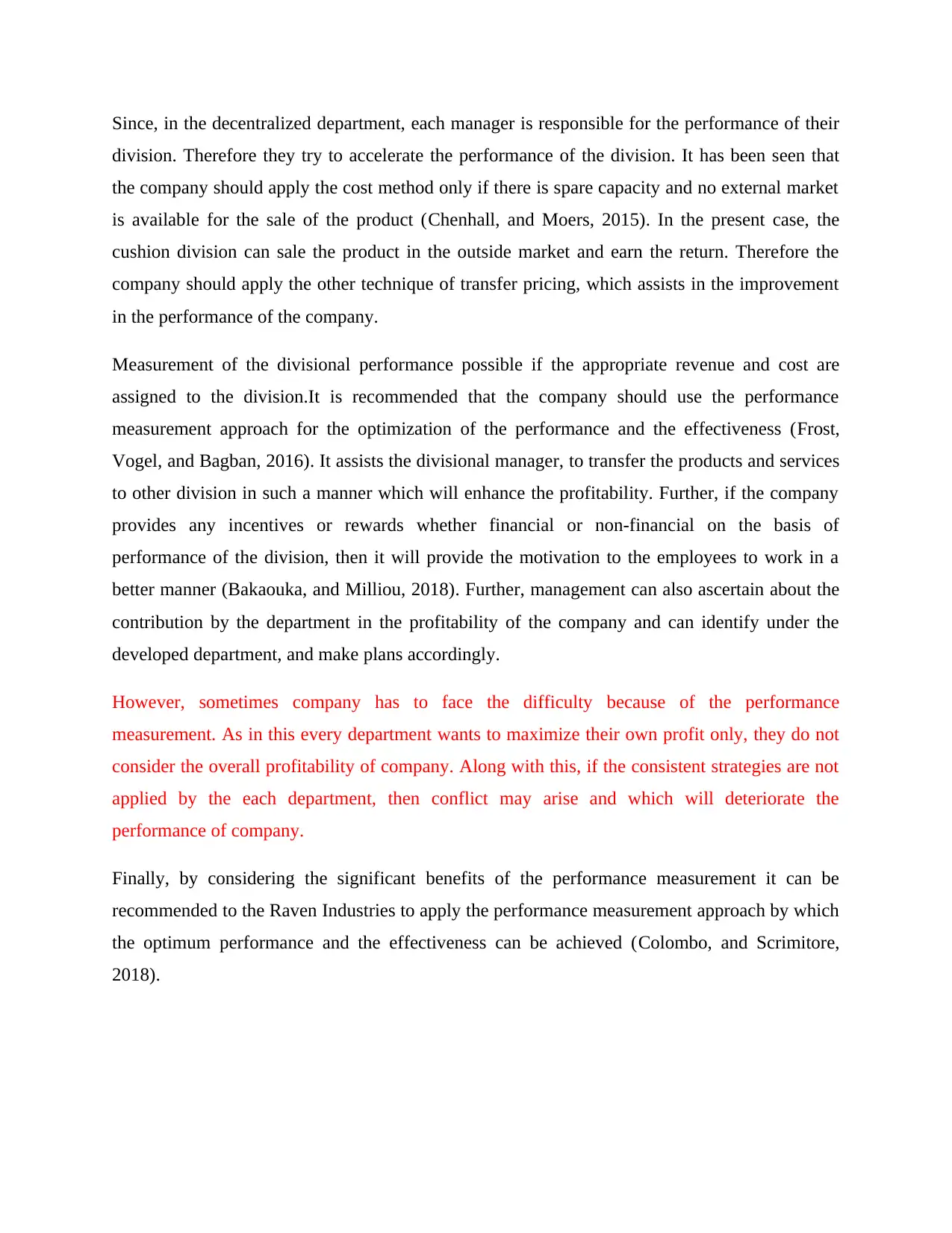
Since, in the decentralized department, each manager is responsible for the performance of their
division. Therefore they try to accelerate the performance of the division. It has been seen that
the company should apply the cost method only if there is spare capacity and no external market
is available for the sale of the product (Chenhall, and Moers, 2015). In the present case, the
cushion division can sale the product in the outside market and earn the return. Therefore the
company should apply the other technique of transfer pricing, which assists in the improvement
in the performance of the company.
Measurement of the divisional performance possible if the appropriate revenue and cost are
assigned to the division.It is recommended that the company should use the performance
measurement approach for the optimization of the performance and the effectiveness (Frost,
Vogel, and Bagban, 2016). It assists the divisional manager, to transfer the products and services
to other division in such a manner which will enhance the profitability. Further, if the company
provides any incentives or rewards whether financial or non-financial on the basis of
performance of the division, then it will provide the motivation to the employees to work in a
better manner (Bakaouka, and Milliou, 2018). Further, management can also ascertain about the
contribution by the department in the profitability of the company and can identify under the
developed department, and make plans accordingly.
However, sometimes company has to face the difficulty because of the performance
measurement. As in this every department wants to maximize their own profit only, they do not
consider the overall profitability of company. Along with this, if the consistent strategies are not
applied by the each department, then conflict may arise and which will deteriorate the
performance of company.
Finally, by considering the significant benefits of the performance measurement it can be
recommended to the Raven Industries to apply the performance measurement approach by which
the optimum performance and the effectiveness can be achieved (Colombo, and Scrimitore,
2018).
division. Therefore they try to accelerate the performance of the division. It has been seen that
the company should apply the cost method only if there is spare capacity and no external market
is available for the sale of the product (Chenhall, and Moers, 2015). In the present case, the
cushion division can sale the product in the outside market and earn the return. Therefore the
company should apply the other technique of transfer pricing, which assists in the improvement
in the performance of the company.
Measurement of the divisional performance possible if the appropriate revenue and cost are
assigned to the division.It is recommended that the company should use the performance
measurement approach for the optimization of the performance and the effectiveness (Frost,
Vogel, and Bagban, 2016). It assists the divisional manager, to transfer the products and services
to other division in such a manner which will enhance the profitability. Further, if the company
provides any incentives or rewards whether financial or non-financial on the basis of
performance of the division, then it will provide the motivation to the employees to work in a
better manner (Bakaouka, and Milliou, 2018). Further, management can also ascertain about the
contribution by the department in the profitability of the company and can identify under the
developed department, and make plans accordingly.
However, sometimes company has to face the difficulty because of the performance
measurement. As in this every department wants to maximize their own profit only, they do not
consider the overall profitability of company. Along with this, if the consistent strategies are not
applied by the each department, then conflict may arise and which will deteriorate the
performance of company.
Finally, by considering the significant benefits of the performance measurement it can be
recommended to the Raven Industries to apply the performance measurement approach by which
the optimum performance and the effectiveness can be achieved (Colombo, and Scrimitore,
2018).
Paraphrase This Document
Need a fresh take? Get an instant paraphrase of this document with our AI Paraphraser
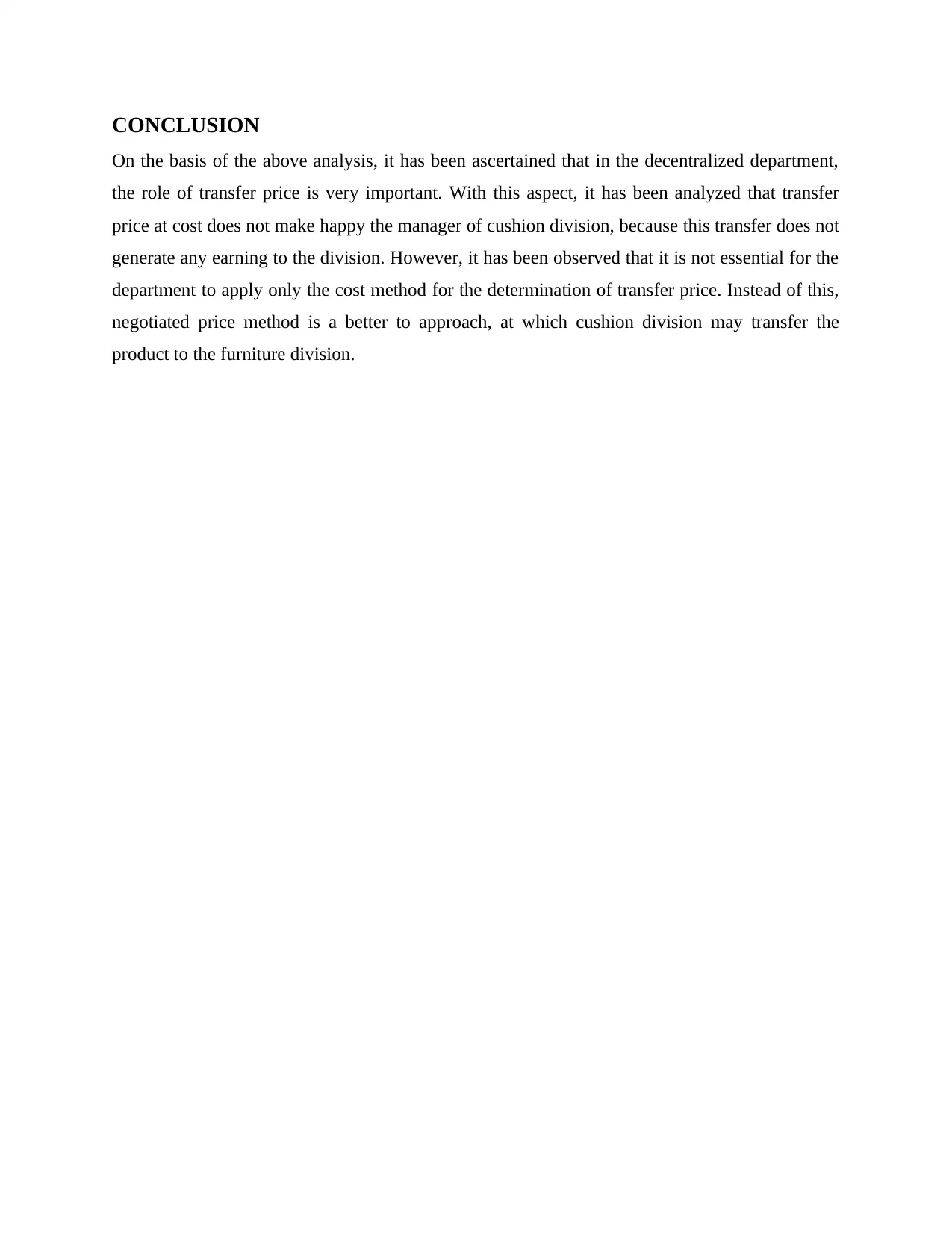
CONCLUSION
On the basis of the above analysis, it has been ascertained that in the decentralized department,
the role of transfer price is very important. With this aspect, it has been analyzed that transfer
price at cost does not make happy the manager of cushion division, because this transfer does not
generate any earning to the division. However, it has been observed that it is not essential for the
department to apply only the cost method for the determination of transfer price. Instead of this,
negotiated price method is a better to approach, at which cushion division may transfer the
product to the furniture division.
On the basis of the above analysis, it has been ascertained that in the decentralized department,
the role of transfer price is very important. With this aspect, it has been analyzed that transfer
price at cost does not make happy the manager of cushion division, because this transfer does not
generate any earning to the division. However, it has been observed that it is not essential for the
department to apply only the cost method for the determination of transfer price. Instead of this,
negotiated price method is a better to approach, at which cushion division may transfer the
product to the furniture division.
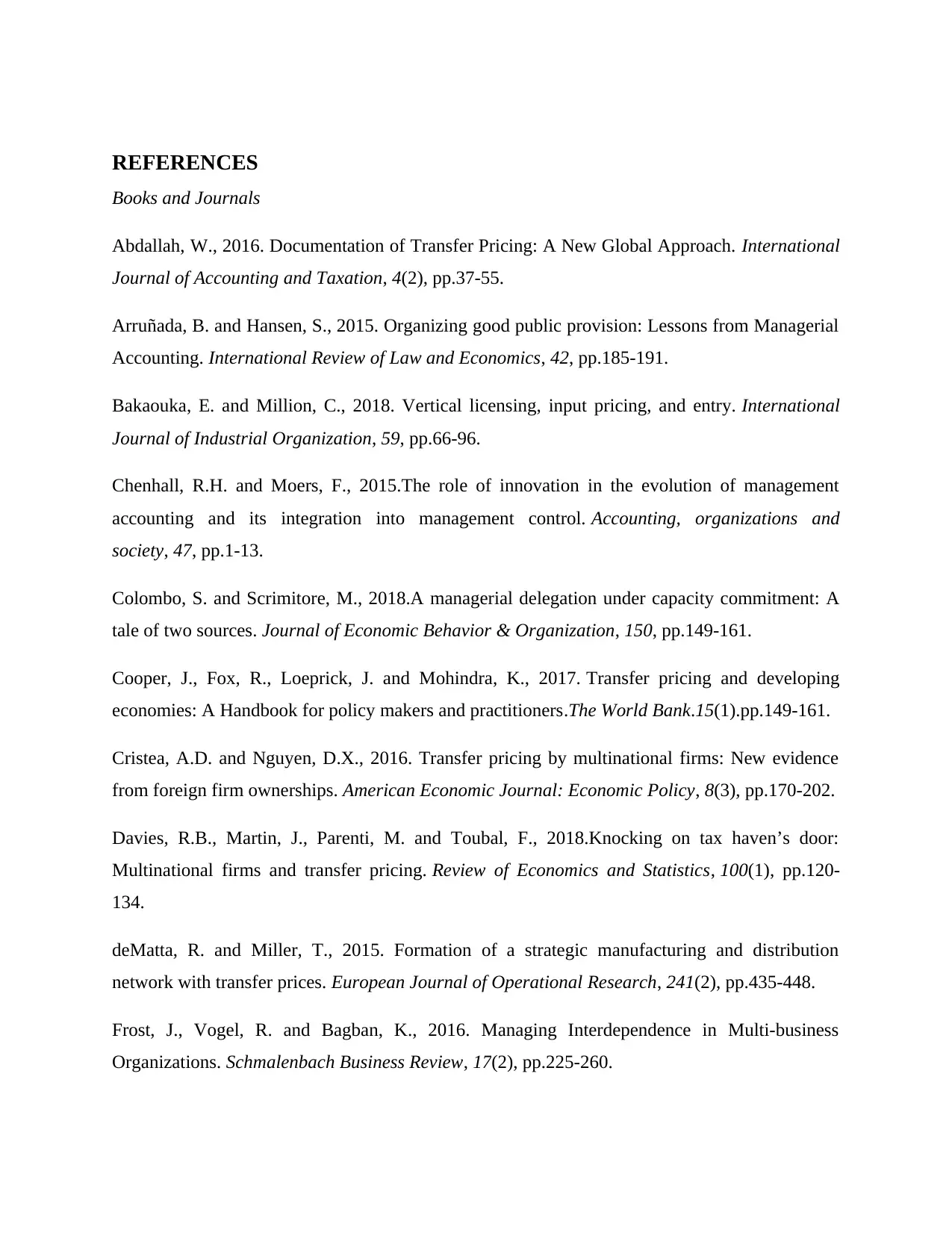
REFERENCES
Books and Journals
Abdallah, W., 2016. Documentation of Transfer Pricing: A New Global Approach. International
Journal of Accounting and Taxation, 4(2), pp.37-55.
Arruñada, B. and Hansen, S., 2015. Organizing good public provision: Lessons from Managerial
Accounting. International Review of Law and Economics, 42, pp.185-191.
Bakaouka, E. and Million, C., 2018. Vertical licensing, input pricing, and entry. International
Journal of Industrial Organization, 59, pp.66-96.
Chenhall, R.H. and Moers, F., 2015.The role of innovation in the evolution of management
accounting and its integration into management control. Accounting, organizations and
society, 47, pp.1-13.
Colombo, S. and Scrimitore, M., 2018.A managerial delegation under capacity commitment: A
tale of two sources. Journal of Economic Behavior & Organization, 150, pp.149-161.
Cooper, J., Fox, R., Loeprick, J. and Mohindra, K., 2017. Transfer pricing and developing
economies: A Handbook for policy makers and practitioners.The World Bank.15(1).pp.149-161.
Cristea, A.D. and Nguyen, D.X., 2016. Transfer pricing by multinational firms: New evidence
from foreign firm ownerships. American Economic Journal: Economic Policy, 8(3), pp.170-202.
Davies, R.B., Martin, J., Parenti, M. and Toubal, F., 2018.Knocking on tax haven’s door:
Multinational firms and transfer pricing. Review of Economics and Statistics, 100(1), pp.120-
134.
deMatta, R. and Miller, T., 2015. Formation of a strategic manufacturing and distribution
network with transfer prices. European Journal of Operational Research, 241(2), pp.435-448.
Frost, J., Vogel, R. and Bagban, K., 2016. Managing Interdependence in Multi-business
Organizations. Schmalenbach Business Review, 17(2), pp.225-260.
Books and Journals
Abdallah, W., 2016. Documentation of Transfer Pricing: A New Global Approach. International
Journal of Accounting and Taxation, 4(2), pp.37-55.
Arruñada, B. and Hansen, S., 2015. Organizing good public provision: Lessons from Managerial
Accounting. International Review of Law and Economics, 42, pp.185-191.
Bakaouka, E. and Million, C., 2018. Vertical licensing, input pricing, and entry. International
Journal of Industrial Organization, 59, pp.66-96.
Chenhall, R.H. and Moers, F., 2015.The role of innovation in the evolution of management
accounting and its integration into management control. Accounting, organizations and
society, 47, pp.1-13.
Colombo, S. and Scrimitore, M., 2018.A managerial delegation under capacity commitment: A
tale of two sources. Journal of Economic Behavior & Organization, 150, pp.149-161.
Cooper, J., Fox, R., Loeprick, J. and Mohindra, K., 2017. Transfer pricing and developing
economies: A Handbook for policy makers and practitioners.The World Bank.15(1).pp.149-161.
Cristea, A.D. and Nguyen, D.X., 2016. Transfer pricing by multinational firms: New evidence
from foreign firm ownerships. American Economic Journal: Economic Policy, 8(3), pp.170-202.
Davies, R.B., Martin, J., Parenti, M. and Toubal, F., 2018.Knocking on tax haven’s door:
Multinational firms and transfer pricing. Review of Economics and Statistics, 100(1), pp.120-
134.
deMatta, R. and Miller, T., 2015. Formation of a strategic manufacturing and distribution
network with transfer prices. European Journal of Operational Research, 241(2), pp.435-448.
Frost, J., Vogel, R. and Bagban, K., 2016. Managing Interdependence in Multi-business
Organizations. Schmalenbach Business Review, 17(2), pp.225-260.
⊘ This is a preview!⊘
Do you want full access?
Subscribe today to unlock all pages.

Trusted by 1+ million students worldwide
1 out of 14
Related Documents
Your All-in-One AI-Powered Toolkit for Academic Success.
+13062052269
info@desklib.com
Available 24*7 on WhatsApp / Email
![[object Object]](/_next/static/media/star-bottom.7253800d.svg)
Unlock your academic potential
Copyright © 2020–2025 A2Z Services. All Rights Reserved. Developed and managed by ZUCOL.



